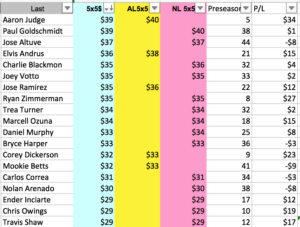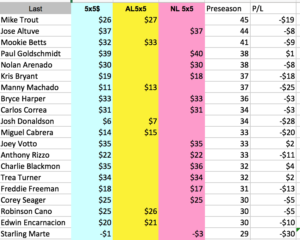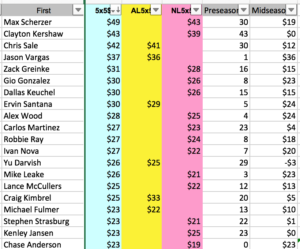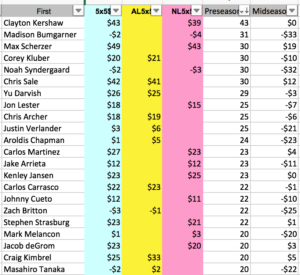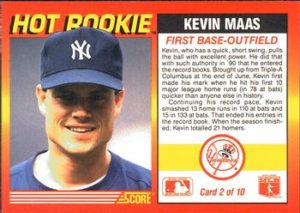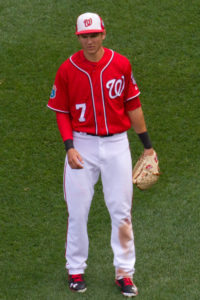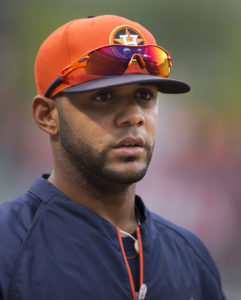People say I’m the belle of spring training
Because I answer questions here
And I won’t say I’m ever complaining
Because I have readers, words, and good beer.
But take a good look at my face
Gary Sanchez might be out of place
If not it’s easy to displace
Devin Mezz-or-a-co.
The process of getting the Patton $ Online projections and prices out the door is iterative. I make different lists and try to locate rankings and projections relationships that don’t make as much sense as they should, and then I change them.
The more I wash-rinse-repeat, the more I fix things. I’ll be the first to admit that while my formulas capture a lot of “talent” in the stats, quirks in playing time, age, injury and development, as well as nutty performances, can screw things up a little, and sometimes a lot. Massaging the projections and prices manually leads to better overall results always.
This week I’m going to be going through the tiers position by position, and see what’s what. Feel free to follow along and comment if you see something awry, on the player pages at pattonandco.com. (Feel free to comment here, if you prefer, but I find the pattonandco.com player pages a better way to chat about players, with more people who know more things about them.)
 TOP TIER: Buster Posey
TOP TIER: Buster Posey
Some are bumping Jonathan Lucroy into Posey’s league, partly because Posey himself dropped down into the area where you might expect to find a healthy Lucroy this year. My take is Buster bounces back up a little after a down year, and LuCroy, who is older, coming off two down years, doesn’t bounce back up quite so far. Even in Texas. And even if Posey hangs tight where he was last year, Lucroy is no lock to catch up to him. Buster stands along, at least for one more year.
TIER TWO: Jonathan Lucroy, JT Realmuto, Willson Contreras, Sal Perez
These guys are good hitters, have some power, and Realmuto has some speed to make up for the power he doesn’t quite have as much of. I can see any of these guys having a year as good as Posey’s, if they get a little lucky. Each could be a disappointment, too. The challenging question here is why Sal Perez and Willson Contreras are in this tier and Evan Gattis and Yadier Molina are in the next one. For me, it’s all about youth and playing time. Perez and Contreras are in the prime of their youth, while Gattis and Molina are moving past it.
TIER THREE: Gary Sanchez, Yadier Molina, Evan Gattis, Stephen Vogt, Brian McCann, Welington Castillo, Yasmani Grandal
So, why is Sanchez down here, and Contreras in the level above? For me it’s about the hit tool. Contreras has it, for sure, which should make him a better bet to improve this year and a better bet not to struggle. Sanchez was incredible last year, and he should get a chance to play even if his batting average falls some because of his good batting eye (Contreras has a pretty good eye, t00), but as his average falls so will his value, even if he hits a lot of homers. That makes him extra valuable in OBP leagues. And if he doesn’t hit as many homers and struggles out of the box? That makes him a little riskier. Not that his struggles are a sure thing, but you have to be aware of them. The rest of these guys are veterans, each with a pretty good track record, but Yasmani Grandal resides here as a reminder of how Sanchez might struggle going forward.
TIER FOUR: Matt Wieters, Devin Mesoraco, Russell Martin, James McCann, Yan Gomes, Derek Norris, Wilson Ramos
One of these guys is really not like the others. That would be Wilson Ramos, who had a terrific 2016 and would be ranked in Group 2 or 3 except that he is rehabbing from ACL and meniscus surgeries late last year. He has said he’ll be ready in May, as a DH. If that’s true he might end up in Tier 3, but the initial prognosis had him back at mid-season, and catchers rehabbing knees have an extra long way to go. I’m bidding him as a half season of a $14 player, considering last year a career year given his past history and age. One other player with caution. Yan Gomes was hurt last year, and the year before. He looks like he should bounce back to being a decent power-hitting catcher with a challenged batting average, but the longer a player struggles with injury the more chances there are for other things to go wrong.
FINAL TIER: Some of these guys will do well, some will crash and burn, or fade away. And the problem is that opportunity isn’t going to be the difference maker. These guys earn their checks with their gloves, for the most part. If they hit, good for their teams, good for their families, great if they’re up for a new contract next year, but if they don’t they likely still have some playing time left. And that can be a double-edged fantasy sword. Still, they should be cheap, and there is some chance
Travis D’Arnaud had Tier Two potential once upon a time, and could land in Tier Three this year if all goes well. But all hasn’t gone well for him, he has a chronic and degenerative hip condition, and that makes him a tough guy to bet on to stay healthy.
Cameron Rupp is coming off a pretty good season, but he probably isn’t really quite that good and he’s blocking, right now, one of the best catching prospects in the game. Will he get a full season? Will he be able to hit .250 again? A lot of questions here, which should knock down his price.
Jett Bandy has a cool name and hits fly balls, which might make him a power hitter at some point. Right now he’s a somewhat wild and undisciplined hitter and better as an idea than an offensive weapon, which he’s going to need to be to continue to earn playing time.
Tucker Barnhart came up as a defense-first catcher, and hit enough when called on last year to remain a viable option if Mesoraco gets hurt again. Or should I say when Mesoraco gets hurt again. But he doesn’t have enough power to be a real force, and there is a good chance he won’t hit .250 again. Which makes playing time concerns disqualifying except late in the endgame.
Sandy Leon did something really silly last year, something that shows you just how misleading baseball statistics can be, at least in a small sample. And good for him. He’ll always be able to say he hit .300. But he’s not hitting .300 again. Doubtful he has another .250 season in him. He is a good defensive catcher and will get some at bats, which in a normal year (unlike last year) would not be a good thing for your fantasy team. The reason he is here is that he hit the ball a lot harder last year than in the past. That sort of thing persists for the best hitters, but fluctuates for the bad ones. There is some chance he could have gotten better last year, which makes him a fair endgame play.
Austin Hedges hasn’t hit in the majors yet, in short stints the last two years, and he comes with the reputation of a good field no hit catcher. Still, he put up breakout numbers in bandbox El Paso last year, good enough for an MLE of .268 and 15 homers in 350 at bats. Don’t bet the gardening budget on that this year, but he should be cheap and if he does do that he’ll be a fantasy plus.
Francisco Cervelli is what he is, to coin a phrase. Good defender, not a total zero with the stick. Totally uninteresting.
Miguel Montero had some good years in Arizona, but he’s not the best catcher on the Cubs and so is unlikely to get enough at bats to contribute much.
Nick Hundley is in a similar position in San Francisco, which will also not have the juicy effect that playing in Coors had.
Tom Murphy! An interesting young catcher who should get a shot at playing time, and may have the bat to contribute, especially playing in Colorado. There’s a good chance he’s going to strike out so much it will be hard for him to stay in the lineup, so take advantage of his low price and hope he figures out how to keep the power while working with a shorter swing.
Tony Wolters was a bit of a nifty pickup last year, because he hit a few homers and stole a few bases. The problem was that three of those steals came in two games in mid April, when he was probably not active for anyone, and after that he didn’t steal another until July. Not cool Tony. Playing time this year is going to depend on just how interesting Tom Murphy turns out to be. There should be enough AB for Wolters to have a couple more good games running, which makes him a viable second catcher, and if Murphy stumbles an uptick is, well, an uptick in PT.
Kurt Suzuki arrived in Minnesota as a no-hit catcher and leaves as a no-hit catcher, but in between had some decent seasons with the bat. Surprising! He might help the Braves this year, in real life, but likely playing mostly against lefties isn’t going to play enough to be more than a fantasy placeholder.
Tyler Flowers will face righties in Atlanta, and will continue to have the career that Tom Murphy seems on track for. Good power, but lots of swings and misses.
Jorge Alfaro is the top catching prospect in the game right now. Fortunately for Cameron Rupp, Alfaro has been contact challenged coming up, which might buy Rupp more time as a starter. Fortunately for Alfaro, Rupp hit enough last year that the Phillies can let Alfaro mature at his own pace. Once Alfaro starts to hit, however, he’ll get the call up and Rupp will sit down.
Jason Castro landed in Minnesota, and has a shot at lots of at bats unless John Ryan Murphy surprises. He’s been pretty feeble the past couple of years, but does have some slight success in his past.
Less Than Zero Tier: John Ryan Murphy, Tomas Telis, Chris Iannetta, Mike Zunino, Josh Phegley, Carlos Ruiz, Alex Avila, Tony Brown, Dioner Navarro, Geovanny Soto, Carlos Perez, Andrew Susac, Austin Barnes, Brayan Pena, Chris Herrman.
These guys are likely to be negative earners if you play them all year in leagues that value opportunity cost at -$4, as I do. If you don’t they’ll probably on average earn a buck each, and a few have a chance to do better than that if there are at bats for them. If you pay a buck for one of these guys and earn $5 you’ve got yourself a steal.
Mike Zunino deserves special mention. He has terrific power, but he also has an amazing swing-and-miss stroke and not great plate discipline. He’s earned a total of $12 the last three years, including a $5 and $9 year. But his bat is so weak when it isn’t blasting, and his organization knows it and is troubled by it, that he isn’t going to be on any sort of long leash. The minors is always a little breeze away for Zunino. Worth a dollar, could be a great addition to a team dumping BA, but could also see 60 at bats and a bus ticket to Korea. Good luck with that.

